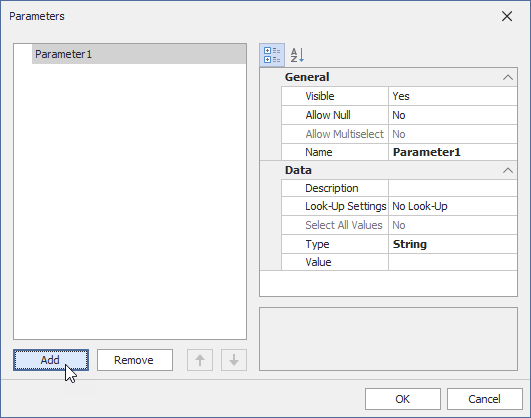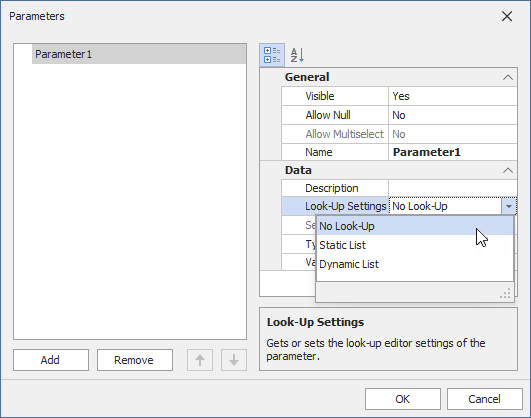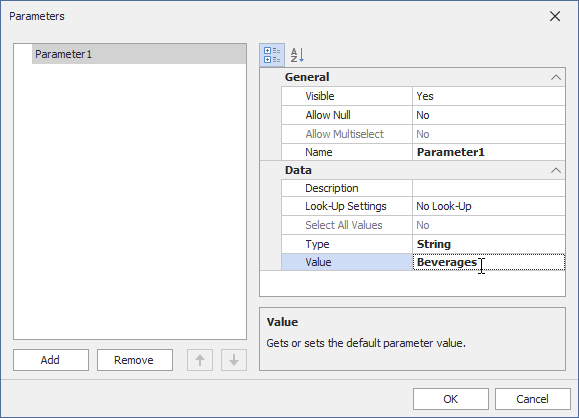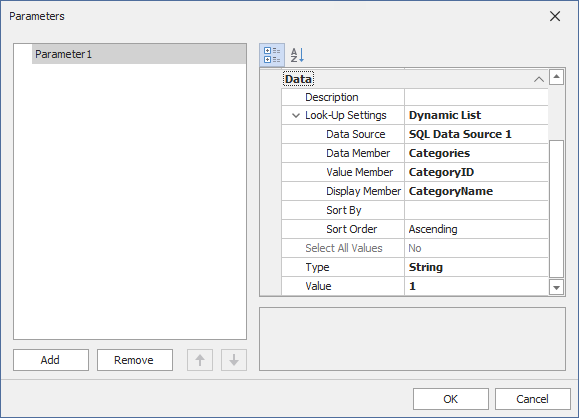Creating Parameters
This topic shows how to add a new dashboard parameter and specify its settings in the Dashboard Designer.
Create a Parameter in the UI
To create dashboard parameters in the Dashboard Designer, follow the steps below.
Click the Parameters button from the Dashboard page group on the Ribbon's Home page.

In the invoked dialog, click the Add button to create a dashboard parameter.

Specify the parameter's settings and click OK to save the created parameter.
Parameter Settings
Name
Specifies the parameter name.
When you create and modify parameter names, follow the rules below:
- A name can contain letters, numbers, and underscores.
- A name cannot contain spaces.
- A name cannot be an empty string.
- The dashboard cannot contain parameters with the same name.
- Names are case-sensitive. For example, you can create the names Parameter and PARAMETER .
Description
Specifies the parameter description displayed in the Parameter column of the Dashboard Parameters dialog.

Visible
Specifies whether the parameter is visible in the Dashboard Parameters dialog.
Allow Null
Specifies whether a null value can be passed as a parameter value.
Allow Multiselect
Specifies whether multi-selection is enabled for the current parameter.
The following limitations apply to parameters with multi-selection enabled:
- Use the Is any of or Is none of operators to pass a multi-select parameter to a filter criteria or to the Expression format condition.
- Use the In or Not In operators to pass a multi-select parameter to a calculated field expression.
Select All Values
Specifies whether all parameter values should be selected in the initial state of the dashboard.
Note that this option is in effect when Allow Multiselect is enabled.
Type
Specifies the parameter type.
The following types are available:
- String
- Date
- Number (16-bit integer)
- Number (32-bit integer)
- Number (64-bit integer)
- Number (floating point)
- Number (double-precision floating point)
- Number (decimal)
- Boolean
- GUID (Globally Unique Identifier)
Value
Specifies the default parameter value.
Note that when the Allow Multiselect option is enabled, the Value option allows you to select multiple parameter values.
Look-Up Settings
Specifies the parameter's look-up settings.
Select the option from the Look-Up Settings drop-down list.

The following Look-Up Settings are available in the WinForms Dashboard:
No Look-Up
An end user can specify the parameter value in the Dashboard Parameters dialog.
You can set the default value for the parameter in the parameter setting:

Static List
An end user selects a parameter value from a static list.
To add predefined parameter values, click the ellipsis button in the parameter settings:

Note
Static List does not support values with leading or trailing whitespace.
Dynamic List
An end user selects a parameter value defined in a data source.

Tip
You can also create cascading parameters in the Dashboard Designer. For more information, refer to the following topic: Cascading Parameters.
To provide access to data source values, specify the following options:
| UI Settings | Description |
|---|---|
| Data Source | Specifies the data source for the dashboard parameter. |
| Data Member | Specifies the name of the data member with the parameter values for SQL and Entity Framework data sources. |
| Value Member | Specifies the name of the data field for the parameter values. |
| Display Member (optional) | Specifies the name of the data field displayed in the Dashboard Parameters dialog as a value description. |
| Sort By (optional) | Specifies the data member used to sort parameter values. |
| Sort Order (optional) | Specifies the sort order. |
"Allow Null" Settings
By changing “Allow Null” to Yes in the dashboard parameter settings, that parameter now has the check box option to return a NULL value.


If the “Allow Null” is set to No instead, it will include n/a rather than allowing a check box eliminating the ability to utilize a filter of NULL in your parameter.


The difference between NULL and BLANK is that NULL represents the absence of a value ever being set while BLANK is an empty string.
Note: JD Edwards generally does not use NULL values in its tables.
NULL Selection

Blank Selection
